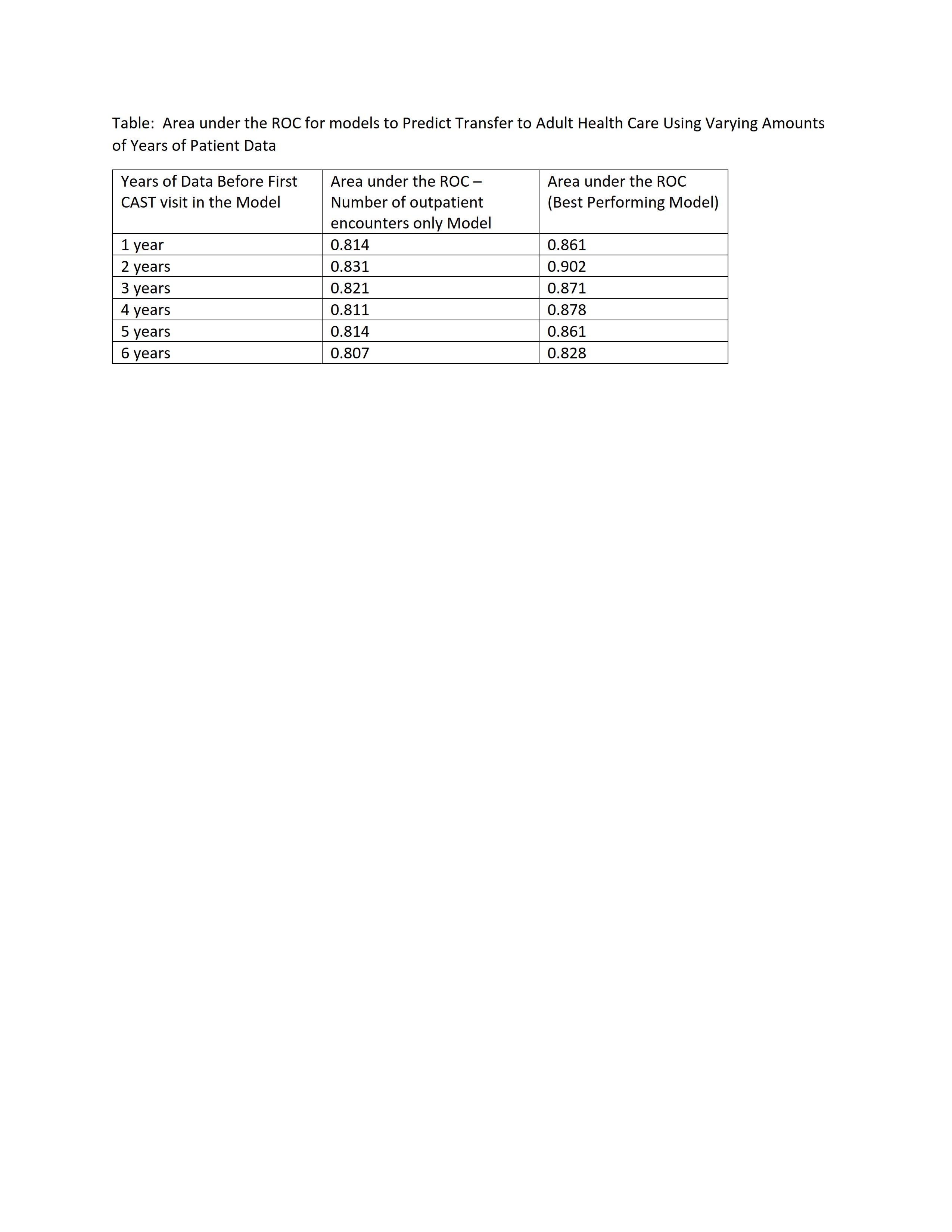Children with Chronic Conditions
Category: Abstract Submission
Children with Chronic Conditions III
601 - Predictors of Timely Transfer to Adult Care in a Cohort of Adolescents and Young Adults on the Autism Spectrum
Monday, April 25, 2022
3:30 PM - 6:00 PM US MT
Poster Number: 601
Publication Number: 601.403
Publication Number: 601.403
Laura C. Hart, The Ohio State University College of Medicine / Nationwide Children's Hospital, Columbus, OH, United States; Joseph W. Sirrianni, Nationwide Children's Hospital, Columbus, OH, United States; Steve Rust, Nationwide Children's Hospital, Columbus, OH, United States; Christopher Hanks, Ohio State University College of Medicine, Hilliard, OH, United States
- LH
Laura C. Hart, MD, MPH (she/her/hers)
Assistant Professor
Nationwide Children's Hospital
Columbus, Ohio, United States
Presenting Author(s)
Background: The transition from pediatric to adult health care is a challenge for adolescents and young adults on the autism spectrum. Data on patient features associated with timely transfer between pediatric and adult health care are limited.
Objective: To describe the patient features associated with timely transfer to adult health care (defined as < 6 months from last pediatric to first adult visit) among a cohort of adolescents and young adults on the autism spectrum.
Design/Methods: We focused on a population of adolescents and young adults on the autism spectrum who established with the Center for Autism Services and Transition (CAST), based at Ohio State University in Columbus, Ohio, for their adult primary care. Patient were included if they had also received their pediatric care at Nationwide Children’s Hospital to accurate linkage of pediatric and adult health care information. The electronic medical records from both hospitals were linked and data from each person’s pediatric health care record were analyzed to determine which patient features were associated with timely transfer to CAST. We generated a logistic regression model using forward selection. Forward selection was performed to select the most informative features, optimizing Akaike Information Criteria (AIC) score (a metric that estimates the prediction error of each feature relative to the other models). At each step in the selection process, the model was evaluated using 5-fold cross validation using the area under the receiver-operator curve (ROC) to determine performance. To ensure predictors were valid and not due to random variation in the data, we looked at patient data at varying time points relative to the first CAST visit (1-, 2-, 3-, 4-, 5-, and 6 years prior).
Results: Demographic characteristics of the study population were as follows: 82% male, 68% White, 15% Black, and a mean age of 18.6 at the last visit in pediatric care. We found that the number of outpatient visits in the pediatric medical record were able to predict a patient’s likelihood of timely transfer with reasonable accuracy at all time points, with the area under the ROC ranging from 0.807 to 0.831. Other patient features were not consistently associated with timely transfer across the various models and did not achieve significant improvement in area under the ROC compared to using outpatient encounters alone (see Table).Conclusion(s): Attendance to appointments in pediatric care showed good ability to predict timely transfer to adult health care in a population of adolescents and young adults on the autism spectrum.
Area under the ROC for models to Predict Transfer to Adult Health Care Using Varying Amounts of Years of Patient Data
Objective: To describe the patient features associated with timely transfer to adult health care (defined as < 6 months from last pediatric to first adult visit) among a cohort of adolescents and young adults on the autism spectrum.
Design/Methods: We focused on a population of adolescents and young adults on the autism spectrum who established with the Center for Autism Services and Transition (CAST), based at Ohio State University in Columbus, Ohio, for their adult primary care. Patient were included if they had also received their pediatric care at Nationwide Children’s Hospital to accurate linkage of pediatric and adult health care information. The electronic medical records from both hospitals were linked and data from each person’s pediatric health care record were analyzed to determine which patient features were associated with timely transfer to CAST. We generated a logistic regression model using forward selection. Forward selection was performed to select the most informative features, optimizing Akaike Information Criteria (AIC) score (a metric that estimates the prediction error of each feature relative to the other models). At each step in the selection process, the model was evaluated using 5-fold cross validation using the area under the receiver-operator curve (ROC) to determine performance. To ensure predictors were valid and not due to random variation in the data, we looked at patient data at varying time points relative to the first CAST visit (1-, 2-, 3-, 4-, 5-, and 6 years prior).
Results: Demographic characteristics of the study population were as follows: 82% male, 68% White, 15% Black, and a mean age of 18.6 at the last visit in pediatric care. We found that the number of outpatient visits in the pediatric medical record were able to predict a patient’s likelihood of timely transfer with reasonable accuracy at all time points, with the area under the ROC ranging from 0.807 to 0.831. Other patient features were not consistently associated with timely transfer across the various models and did not achieve significant improvement in area under the ROC compared to using outpatient encounters alone (see Table).Conclusion(s): Attendance to appointments in pediatric care showed good ability to predict timely transfer to adult health care in a population of adolescents and young adults on the autism spectrum.
Area under the ROC for models to Predict Transfer to Adult Health Care Using Varying Amounts of Years of Patient Data

